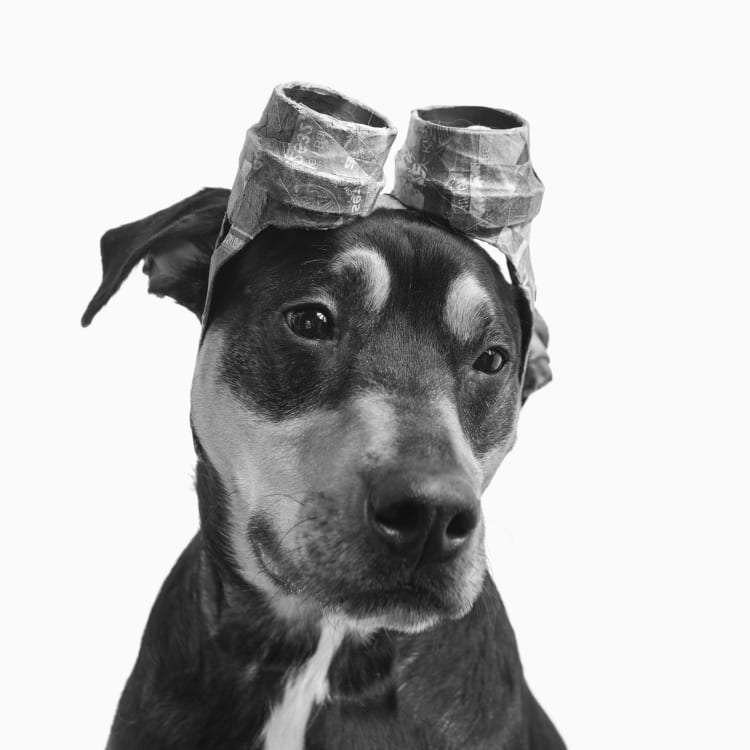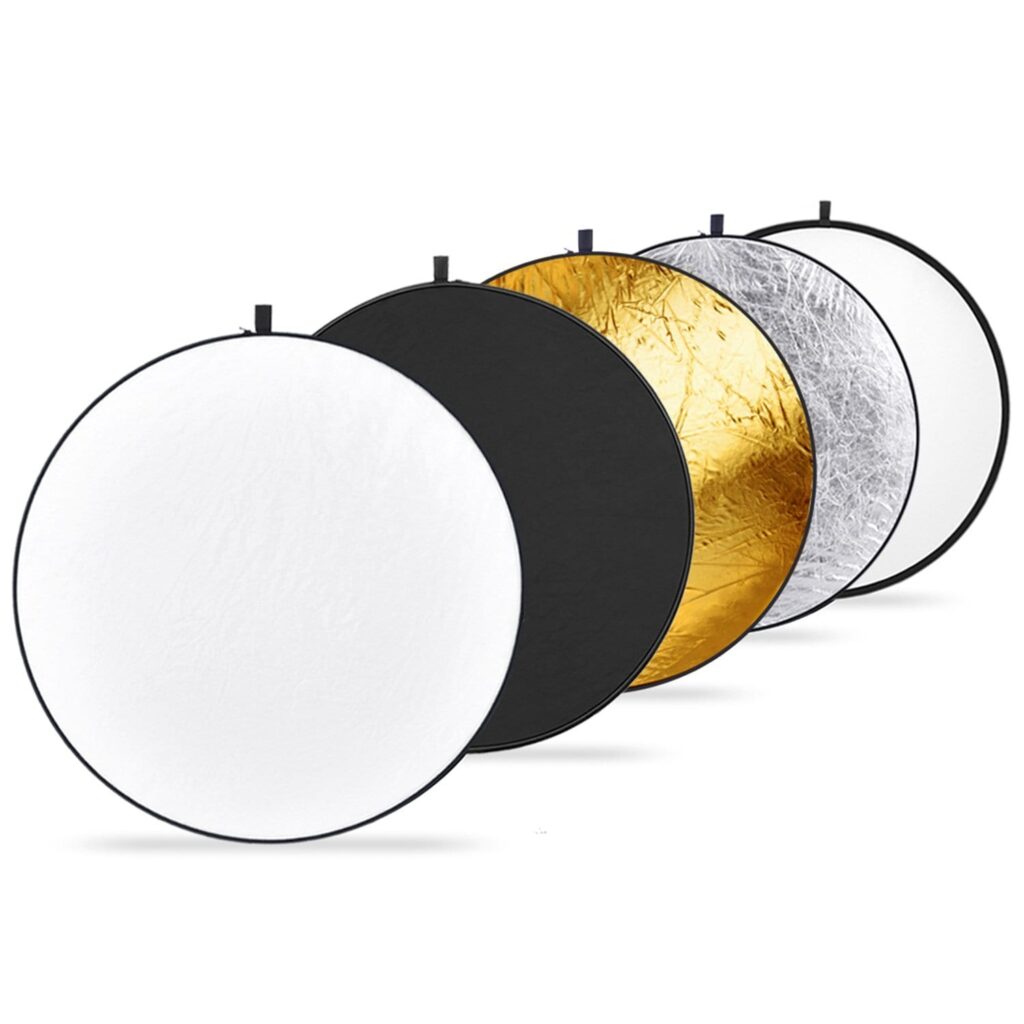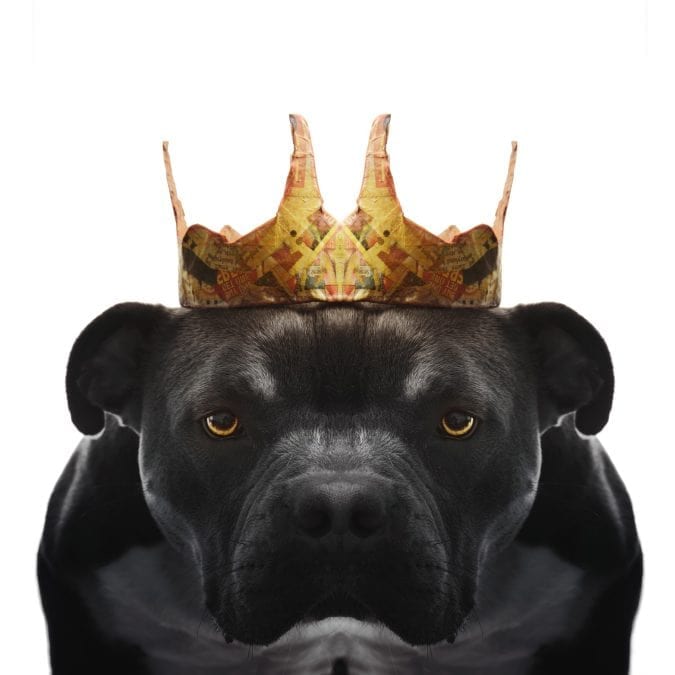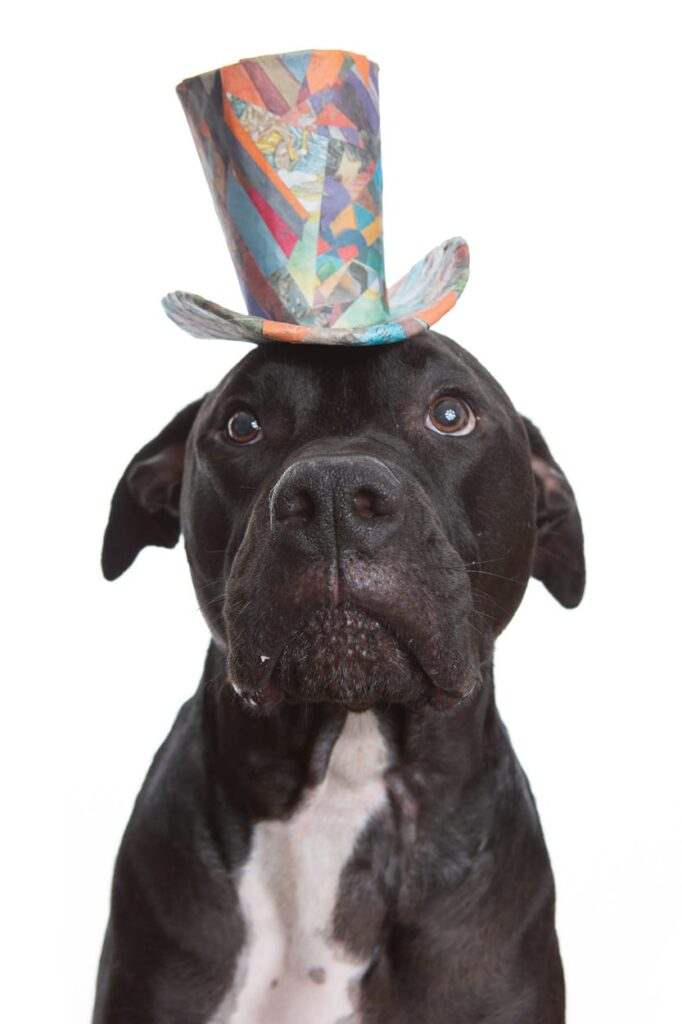Written by J.B. Shepard, a professional pet photographer and founder of the Puptrait Studio.
Photographing black dogs can be tricky. But it’s not as difficult as many aspiring dog photographers have been led to believe. In fact, with a better understanding of light and reflections it is possible to take great photos of black and dark furred dogs consistently.
Black Dog Photography Tips & Tricks
We’ve put together a collection of tips and tricks to help pet photographers create better black dog portraits. Please note that all of these technique and gear suggestions assume that photographers following along at home are shooting using manual exposure controls and not in any program mode.
If you are unsure about the capabilities of your camera, we strongly recommend first reading our photography student camera guide before proceeding with this tutorial.
Remember that fur is different from skin
Dogs are covered in fur. Fur picks up light differently than skin.
While this might sound obvious, this is one of the most common mistakes that aspiring pet photographers make.
Often, they don’t even realize they’re doing it and honestly, it’s not really their fault. Unless you went to art school or studied through a technical photography program, odds are you started learning photography as a hobbyist – focused primarily on learning specific applied techniques (related to landscapes or human portraits), rather than technical theory and more foundational concepts.
What works photographing people, doesn’t always translate with dogs
What works great with skin often doesn’t translate well to capturing fur
This is especially true when evaluating the quality of light created by various lighting arrangements or different sized modifiers and light sources.
While softer light might be “better” for human portraits because it will help hide wrinkles, blemishes and other imperfections in skin. Those same qualities will also hide finer fur details. Which isn’t a big deal when photographing pets with lighter colored coats. But when photographing dogs with dark fur, often you’re left with only those more subtle details to work with — namely changes in reflection and texture created by individual hairs laying in different directions.
You don’t need to go to art school to become a great photographer
A formal art or photography education can be a great way to learn quickly, but does tend to present knowledge blind spots – particularly when presented with more unique situations or extreme challenges. It is important to understand that many of the lighting and photography techniques presented early in your education as being “generally a good idea” or a “rule-of-thumb” are often in actuality bad habits when working with furry pets.

A short fur black and fawn colored puppy captured at the Puptrait Studio in Baltimore for a Washington D.C. dog lover.
At the end of the day, fur is really just short hair
In many ways, photographing a dog portrait is very similar to photographing hair. In fact, many of the lighting techniques that we depend as professional pet photographers to create sharp and detailed pet portraits, are ones that we picked up working with salons, MUA’s and beautician clients before we began working exclusively with pets.
When working with hair, you need to break what are generally regarded as hard and fast rules. This is for the simple fact that shiny skin is generally regarded as a bad thing, but having sleek and shiny hair is actually quite positive.
Use hard light when working with fur
Soft light is generally regarded in photography as better. When capturing human portraits, soft light can help hide wrinkles, frown and smiles lines, and blemishes. But we rarely have any of these concerns when working with dogs. More over, this type of light tends to wash out details. As demonstrated in the diagrams below, it is better to use harder light when working with surfaces that depend on texture for contrast.
How to generate hard light
Direct natural light on clear and cloudless days is often quite harsh, but can be difficult to work with as it may present extreme contrasts, harsh shadows, and approach from less than flattering angles. Which is why whether working with dogs inside or outdoors that it is usually a good idea to photograph dogs with flash, though you may be able to achieve similar effects with a silver reflector.

Parabolic umbrellas are great for lighting dogs with dark or black fur — especially when used without a diffuser. This silver lined EZ Lock parabolic umbrella includes a detachable grid, external diffuser, internal diffuser, reversible deflection cap disk, and Bowens Mount Speedring adapter. Not too shabby for costing only $95.
Deep Parabolic Umbrellas are a pet photographers best friend
Generally when working with dogs you want a larger light modifier that focuses on converging light rather than spreading. Deeper parabolic umbrellas work wonderfully when shooting dogs with black fur – as the reflected light effectively forms a beam.
48″ umbrellas tend to work well when photographing most dog breeds without any additional modifiers (such as diffusers), but you may want to consider also using an eggcrate or grid when photography smaller dogs and puppies with black fur.
Snoots, grids and beauty dishes can also work well. Avoid using ring lights, shoot through umbrellas, soft boxes, scrims and other diffused light sources when photographing black dogs.
Shop for Parabolic Umbrellas Online
When it comes to lighting, size matters (but bigger isn’t always better)
It’s also important to note that the size and location of your light source also matters. The wider the visual subtended angle of a light source in relationship to a subject, the softer the light and visa versa.

This Fotodiox Pro 16-Rib, 72″ Black and Silver Reflective Parabolic Umbrella is a great lighting modifier — especially handy when lighting environmental pet portraits on location from a distance or larger group shots. But is tad bit too large to light solo pet portraits, especially when working with dogs with dark fur or up close with a wider lens.
Translated into simpler practical terms, larger and closer light sources tend to produce softer light than smaller light sources located further from subjects. That all said, film is wicked cheap these days – especially if you shoot digital 😉
So, don’t be afraid to experiment with different lighting arrangements and placements. When working with a smaller subject, such as a dog, you might be surprised how much of a difference even a few inches makes.
PRO TIP: When photographing dogs on location remember that many light modifiers, especially reflective umbrellas, will turn into kites in windy conditions. Be sure to bring plenty of sand bags or help when packing for your shoot.

Specular reflections are good
“Specular” means “having the properties of a mirror” and contrary to what you may read in photography forums, specular specifically refers to reflections, not lights. When photographing skin, it is usually best to avoid specular reflections, as they may pickup as hot spots or make your subject look oily or greasy. But when you are lighting hair or fur, you typically want it to shine, as a good sheen is generally regarded as a sign of a healthy coat.
If the dog you are photographing has a solid black coat (common with Black Labs, Affenpinschers, and bully puppies) capturing this sheen might be the only way to capture texture details in the snout and face.
Expose to the sheen, not the fur
If a dog’s fur is actually black, you’re not going to have much luck with programmed or automatic exposure modes. This is one of those situations where learning to use the manual setting on your camera will be tremendously helpful.
The reason for this is pretty straightforward. Your camera can not distinguish between what is black and what is dark, for the simple fact that what we perceive as the color black is actually the absence of reflected light.
To photograph a dog with black fur we to focus on exposing to the elements of the fur (usually those sections around the snout and eyes) that are not actually black or are specular (i.e. the sheen).
Avoid harsh shadows
Just because you’re using a harsh light source, doesn’t mean that you need to or should settle for harsh shadows. Don’t be afraid to use a reflector to bounce light into shadows or to even use a second strobe as a fill. But remember that contrast requires both light and dark. Be careful not to wash out any fur details you are lighting with your key light, but the rest of the frame can be lit to taste.

Reflectors come in all shapes and sizes. This smaller $8 hand held reflector is great at filling harsher shadows when photographing black dog pet portraits.
Reflectors are an absolute must when photographing black dogs
If you’ve read any of our camera guides, you probably already know how we feel about most photography accessories. In short – we’re not big fans. New photographers have a tendency to buy a lot of nonsense like gimmicky light modifiers, cheap filters, and novelty lenses they simply don’t need.
To be clear, reflectors absolutely do not fall in this category.

For only $20 a 43″ 5-in-1 pop-up reflector provides photographers with a ton of creative freedom. This tool can be used to fill harsh shadows, highlight details, soften harsh light, block unwanted light and even change the color of reflected light.
Where most cheaper entry level photo accessories grow increasingly less useful as beginning photographers grow more skilled. Reflectors actually become more useful. Considering that they’re generally pretty durable, that different size and shape reflectors serve different purposes, and that they’re one of the most affordable pieces of gear you can buy, a reflector is almost always a solid investment.
I would go so far as to say that every aspiring pet photographer should at minimum own a collapsible 5-in-1 disc reflector and a smaller handheld reflector. It doesn’t matter if you only shoot with flash, studio style strobes or outside with natural light. These two types of reflectors are useful in virtually all shooting environments and at all skill levels.
Don’t have $30 to spend on gear? Make your own. A reflector is just a flat shiny thing. They’re really not that hard to make, but the functionality they provide can absolutely make or break a portrait session — especially when trying to light a black dog.
Photographing dogs with black fur will make you a better pet photographer
While photographing black dogs can present a few challenges. These beautiful dark furred dogs provide a lot of opportunities to test pet photographers, helping them hone their lighting skills and expressive their creativity.
Remember that when it comes to learning photography, especially lighting, that trial and error is key. But through practice and trying new lighting arrangements it is possible for even new photographers to create amazing images of their pets — even if they have dark or black fur.
Just keep shooting!
The Puptrait Studio may collect a share of sales or other compensation from the links on this page. Prices are accurate and items in stock as of time of publication.
About the author: J.B. Shepard, is a professional pet photographer, dog advocate, and founder of the Puptrait Studio. J.B. lives in Hampden, with his wife and two dogs — George (a Boggle) and Lucky (Jack Russell Terrier).





